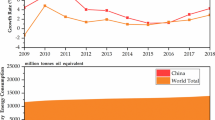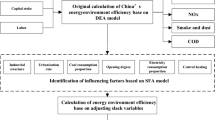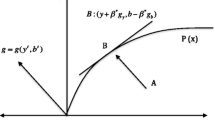Abstract
Increased environmental pollution and energy consumption caused by the country’s rapid development has raised considerable public concern, and has become the focus of the government and public. This study employs the super-efficiency slack-based model–data envelopment analysis (SBM–DEA) to measure the total factor energy efficiency of 30 provinces in China. The estimation model for the spatial interaction intensity of regional total factor energy efficiency is based on Wilson’s maximum entropy model. The model is used to analyze the factors that affect the potential value of total factor energy efficiency using spatial dynamic panel data for 30 provinces during 2000–2014. The study found that there are differences and spatial correlations of energy efficiency among provinces and regions in China. The energy efficiency in the eastern, central, and western regions fluctuated significantly, and was mainly because of significant energy efficiency impacts on influences of industrial structure, energy intensity, and technological progress. This research is of great significance to China’s energy efficiency and regional coordinated development.


Similar content being viewed by others
References
Ai H, Deng Z, Yang X (2015) The effect estimation and channel testing of the technological progress on China’s regional environmental performance. Ecol Indic 51:67–78
Alam A, Azam M, Abdullah AB, Malik IA, Khan A, Hamzah TA, Faridullah, Khan MM, Zahoor H, Zaman K (2015) Environmental quality indicators and financial development in Malaysia: Unity in diversity. Environ Sci Pollut Res 22(11):8392–8404
Bian Y, Lv K, Yu A (2017) China’s regional energy and carbon dioxide emissions efficiency evaluation with the presence of recovery energy: an interval slacks-based measure approach. Ann Oper Res 255(1–2):301–321
Carvalho H, Govindan K, Azevedo SG, Cruz-Machado V (2017) Modeling green and lean supply chains: an eco-efficiency perspective. Resour Conserv Recycl 120:75–87
Chen Y, Liu B, Shen Y, Wang X (2016) The energy efficiency of China’s regional construction industry based on the three-stage DEA model and the DEA-DA model. KSCE J Civ Eng 20(1):34–47
Cheng Y, Wang Z, Zhang S, Ye X, Jiang H (2013) Spatial econometric analysis of carbon emission intensity and its driving factors from energy consumption in China. Acta Geograph Sin 68(10):1418–1431
Costantini V, Crespi F, Palma A (2017) Characterizing the policy mix and its impact on eco-innovation: a patent analysis of energy-efficient technologies. Res Policy 46(4):799–819
Govindan K, Sivakumar R (2016) Green supplier selection and order allocation in a low-carbon paper industry: integrated multi-criteria heterogeneous decision-making and multi-objective linear programming approaches. Ann Oper Res 238(1):1–34
Guan W, Xu S (2016) Study of spatial patterns and spatial effects of energy eco-efficiency in China. J Geogr Sci 26(9):1362–1376
Gul S, Zou X, Hassan CH, Azam M, Zaman K (2015) Causal nexus between energy consumption and carbon dioxide emission for Malaysia using maximum entropy bootstrap approach. Environ Sci Pollut Res 22(24):1–13
Gunasekaran A (2014) Managing organizations for sustainable development in emerging countries: an introduction. Int J Sustain Dev World Ecol 21(3):195–197
Guo W, Sun T (2013) Chinese industries’ ecological total factor energy efficiency. Chinese. J Manag 11:018
Hang L, Tu M (2007) The impacts of energy prices on energy intensity: evidence from China. Energy Policy 35(5):2978–2988
Hu JL, Wang SC (2006) Total-factor energy efficiency of regions in China. Energy Policy 34(17):3206–3217
LeSage JP, Pace RK (2008) Spatial econometric modeling of origin-destination flows. J Reg Sci 48(5):941–967
Li B, Wu S (2016) Effects of local and civil environmental regulation on green total factor productivity in china: a spatial Durbin econometric analysis. J Clean Prod 153:342–353
Lin B, Liu W (2017) Analysis of energy efficiency and its influencing factors in China’s transport sector. J Clean Prod 9:170
Long R, Wang H, Chen H (2015) Regional differences and pattern classifications in the efficiency of coal consumption in China. J Clean Prod 112(5):3648–3691
Long R, Shao T, Chen H (2016) Spatial econometric analysis of China’s province-level industrial carbon productivity and its influencing factors. Appl Energy 166:210–219
Lv W, Hong X, Fang K (2015) Chinese regional energy efficiency change and its determinants analysis: Malmquist index and Tobit model. Ann Oper Res 228(1):1–14
Lv K, Yu A, Bian Y (2017) Regional energy efficiency and its determinants in china during 2001–2010: a slacks-based measure and spatial econometric analysis. J Prod Anal 47(1):1–17
Ohlin BG (1934) Interregional and international trade, revised ed. 1967. Harvard University Press, Cambridge
Pace RK, LeSage JP (2006) Interpreting spatial econometric models. Paper presented at the Regional Science Association International North American meetings, Toronto, Ontario, Canada
Pan X, Liu Q, Peng X (2015) Spatial club convergence of regional energy efficiency in China. Ecol Indic 51:25–30
Prasad VK (2005) Geographic information systems for transportation—principles and applications. Photogramm Rec 20(112):394–195
Qian ZM, Liu XC (2013) Regional differences in china’s green economic efficiency and their determinants. China Popul Resour Environ 23(7):104–109
Ravenstein EG (1976) The laws of migration. J Stat Soc 151(1385):289–291
Rawski TG (2001) What is happening to China’s GDP statistics? China Econ Rev 12(4):347–354
Rey SJ (2001) Spatial empirics for economic growth and convergence. Geogr Anal 33(3):195–214
Rojas-Cardenas JC, Hasanbeigi A, Sheinbaum-Pardo C, Price L (2017) Energy efficiency in the Mexican iron and steel industry from an international perspective. J Clean Prod 158:335–348
Schleich J, Rogge K, Betz R (2009) Incentives for energy efficiency in the EU emissions trading scheme. Energy Effic 2(1):37–67
Sinton JE (2001) Accuracy and reliability of China’s energy statistics. China Econ Rev 12(4):373–383
Sinton JE, Fridley DG (2000) What goes up: recent trends in China’s energy consumption. Energy Policy 28(10):671–687
Song M, Peng J, Wang J, Zhao J (2017) Environmental efficiency and economic growth of China: a ray slack-based model analysis. Eur J Oper Res In Press
Stern DI (2015) Energy-GDP relationship. Palgrave Macmillan, Basingstoke
Stouffer SA (1940) Intervening opportunities: a theory relating mobility and distance. Am Sociol Rev 5(6):845–867
Tone K (2001) A slacks-based measure of efficiency in data envelopment analysis. Eur J Oper Res 130(3):498–509
Tone K (2002) A strange case of the cost and allocative efficiencies in DEA. J Oper Res Soc 53(11):1225–1231
Ullman EL (1957) American commodity flow. A geographical interpretation of rail and water traffic based on principles of spatial interchange. [With maps.]. University of Washington Press, Seattle and London
Wang ZH, Zeng HL, Wei YM, Zhang YX (2012) Regional total factor energy efficiency: an empirical analysis of industrial sector in China. Appl Energy 97(9):115–123
Wang Q, Fan J, Shidai WU (2014) Spatial-temporal variation of regional energy efficiency and its causes in China, 1990–2009. Geogr Res 33(1):43–56
Wilson AG (1967) A statistical theory of spatial distribution models. Transp Res 1(3):253–269
Ying-Zhi XU, Guan JW (2011) On the convergence of regional energy efficiency in China: a perspective of spatial economics. J Financ Econ 37:112–123
Yuxiang K, Chen Z (2010) Government expenditure and energy intensity in China. Energy Policy 38(2):691–694
Zhang J, Wu GY, Zhang JP (2004) Estimation of China provincial material capital stocks: 1952–2000. Econ Res (10):35–44 (In Chinese)
Zhang N, Kong F, Yu Y (2015) Measuring ecological total-factor energy efficiency incorporating regional heterogeneities in China. Ecol Indic 51:165–172
Zuo ZM, Yang L (2011) Analysis of total factor energy efficiency in China: based on SBM model. Stat Decis 20:105–107
Author information
Authors and Affiliations
Corresponding author
Additional information
Responsible editor: Philippe Garrigues
Rights and permissions
About this article
Cite this article
Song, M., Chen, Y. & An, Q. Spatial econometric analysis of factors influencing regional energy efficiency in China. Environ Sci Pollut Res 25, 13745–13759 (2018). https://doi.org/10.1007/s11356-018-1574-5
Received:
Accepted:
Published:
Issue Date:
DOI: https://doi.org/10.1007/s11356-018-1574-5




